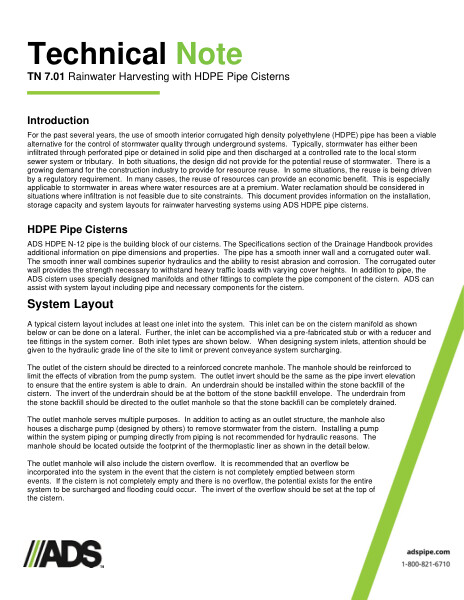TN 7.01 Rainwater Harvesting with HDPE Pipe Cisterns
Filename:
TN 7.01 Rainwater Harvesting with HDPE Pipe Cisterns.pdf

This document is the TN 7.01 Rainwater Harvesting with HDPE Pipe Cisterns. System layouts, cross sections with descriptions provided.
For the past several years, the use of smooth interior corrugated high density polyethylene (HDPE) pipe has been a viable alternative for the control of stormwater quality through underground systems. Typically, stormwater has either been infiltrated through perforated pipe or detained in solid pipe and then discharged at a controlled rate to the local storm sewer system or tributary. In both situations, the design did not provide for the potential reuse of stormwater. There is a growing demand for the construction industry to provide for resource reuse. In some situations, the reuse is being driven by a regulatory requirement. In many cases, the reuse of resources can provide an economic benefit. This is especially applicable to stormwater in areas where water resources are at a premium. Water reclamation should be considered in situations where infiltration is not feasible due to site constraints.
This document provides information on the installation, storage capacity and system layouts for rainwater harvesting systems using ADS HDPE pipe cisterns.
HDPE Pipe Cisterns has the ADS HDPE N-12 pipe as the building block of our cisterns. The pipe has a smooth inner wall and a corrugated outer wall. The smooth inner wall combines superior hydraulics and the ability to resist abrasion and corrosion. The
corrugated outer wall provides the strength necessary to withstand heavy traffic loads with varying cover heights.
In addition to pipe, the ADS cistern uses specially designed manifolds and other fittings to complete the pipe component of the cistern.
Tips for a cistern layout included an example cistern layout illustration showing the inlets, 4” HDPE vent, limit of thermoplastic liner and outlet manhole with discharge pump. A 2nd illustration shows an outlet manhole typical detail.
Storage capacities are explained and a pipe storage capacity chart is included.
Installation steps are explained and a typical cistern cross section shows the details.
The thermoplastic liner is discussed with a liner pipe connection detail provided.
Cistern design offers formulas to size the pipes and beds needed.
